Lebanese vs Inupiat Community Comparison
COMPARE
Lebanese
Inupiat
Social Comparison
Social Comparison
Lebanese
Inupiat
7,328
SOCIAL INDEX
70.8/ 100
SOCIAL RATING
122nd/ 347
SOCIAL RANK
2,695
SOCIAL INDEX
24.5/ 100
SOCIAL RATING
244th/ 347
SOCIAL RANK
Inupiat Integration in Lebanese Communities
The statistical analysis conducted on geographies consisting of 87,869,295 people shows a slight negative correlation between the proportion of Inupiat within Lebanese communities in the United States with a correlation coefficient (R) of -0.065. On average, for every 1% (one percent) increase in Lebanese within a typical geography, there is a decrease of 0.004% in Inupiat. To illustrate, in a geography comprising of 100,000 individuals, a rise of 1,000 Lebanese corresponds to a decrease of 4.4 Inupiat.
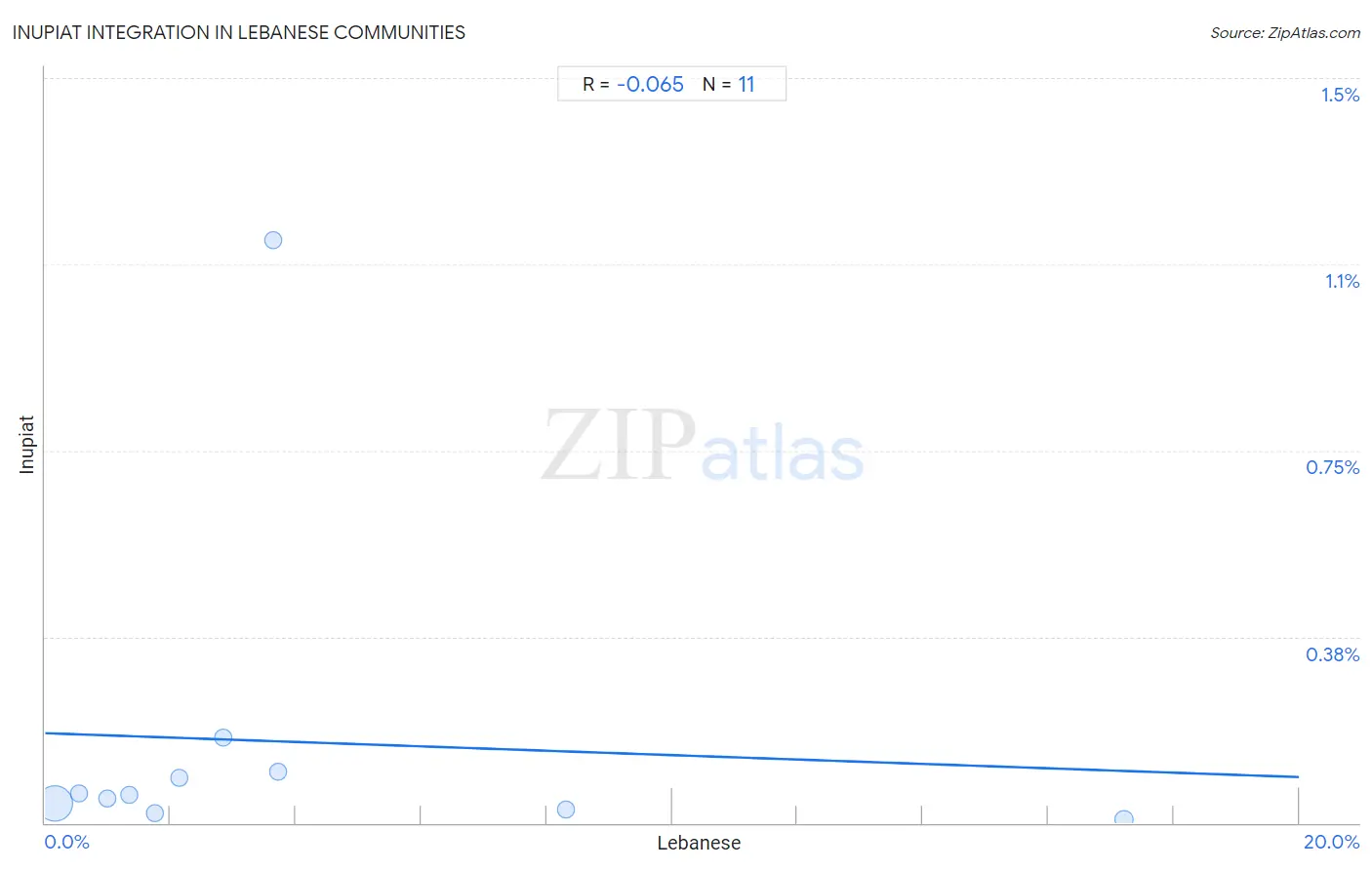
Lebanese vs Inupiat Income
When considering income, the most significant differences between Lebanese and Inupiat communities in the United States are seen in wage/income gap (27.9% compared to 20.8%, a difference of 34.2%), per capita income ($45,840 compared to $36,999, a difference of 23.9%), and median male earnings ($57,409 compared to $47,281, a difference of 21.4%). Conversely, both communities are more comparable in terms of median female earnings ($40,006 compared to $40,080, a difference of 0.18%), householder income over 65 years ($62,287 compared to $61,061, a difference of 2.0%), and householder income under 25 years ($50,355 compared to $55,935, a difference of 11.1%).

| Income Metric | Lebanese | Inupiat |
| Per Capita Income | Exceptional $45,840 | Tragic $36,999 |
| Median Family Income | Exceptional $107,086 | Tragic $91,730 |
| Median Household Income | Excellent $88,091 | Tragic $78,841 |
| Median Earnings | Exceptional $48,226 | Tragic $43,000 |
| Median Male Earnings | Exceptional $57,409 | Tragic $47,281 |
| Median Female Earnings | Good $40,006 | Good $40,080 |
| Householder Age | Under 25 years | Tragic $50,355 | Exceptional $55,935 |
| Householder Age | 25 - 44 years | Excellent $97,339 | Tragic $84,619 |
| Householder Age | 45 - 64 years | Exceptional $104,734 | Tragic $91,355 |
| Householder Age | Over 65 years | Good $62,287 | Average $61,061 |
| Wage/Income Gap | Tragic 27.9% | Exceptional 20.8% |
Lebanese vs Inupiat Poverty
When considering poverty, the most significant differences between Lebanese and Inupiat communities in the United States are seen in receiving food stamps (11.1% compared to 20.1%, a difference of 80.2%), single male poverty (13.2% compared to 20.0%, a difference of 50.9%), and female poverty among 25-34 year olds (13.2% compared to 18.5%, a difference of 40.5%). Conversely, both communities are more comparable in terms of single mother poverty (29.4% compared to 29.0%, a difference of 1.4%), child poverty among boys under 16 (16.6% compared to 18.1%, a difference of 9.2%), and single father poverty (17.7% compared to 19.5%, a difference of 10.0%).
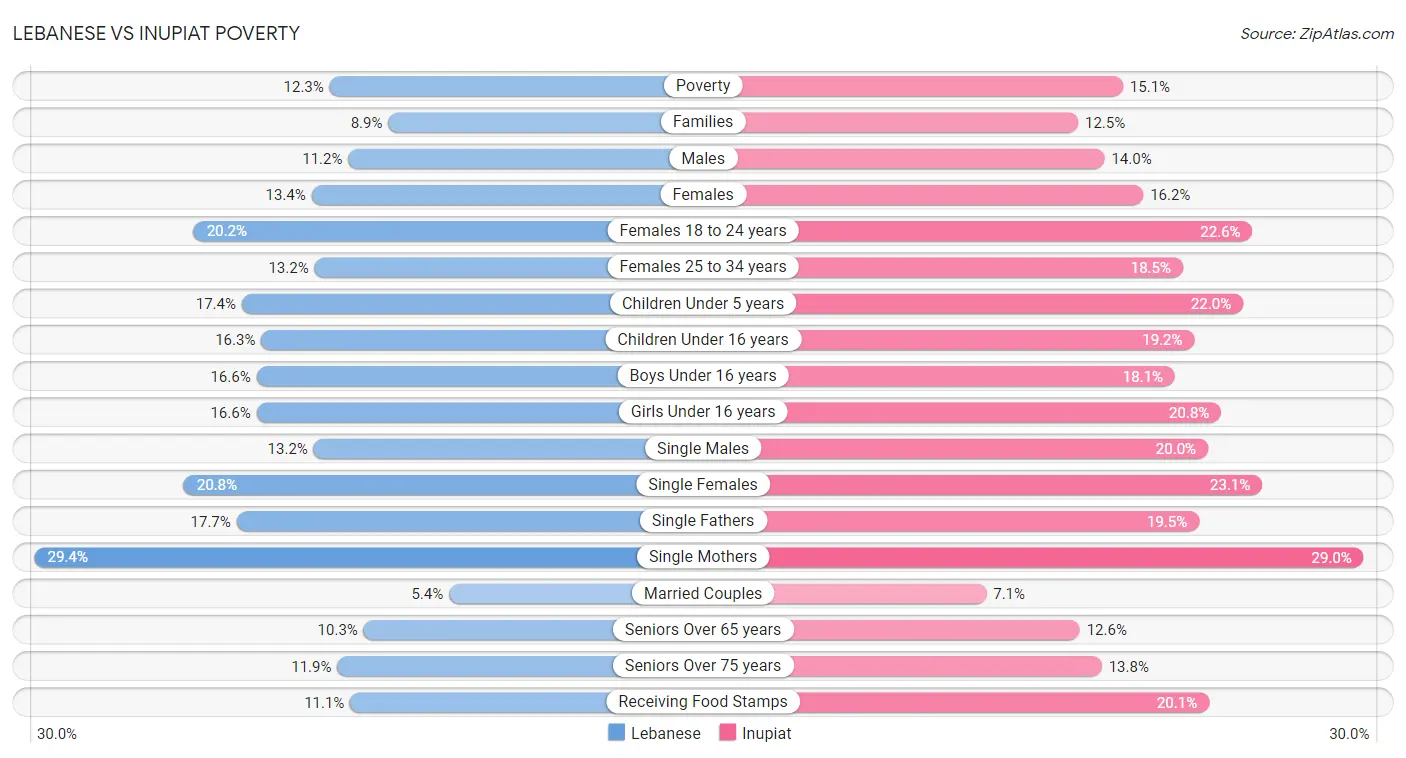
| Poverty Metric | Lebanese | Inupiat |
| Poverty | Average 12.3% | Tragic 15.1% |
| Families | Average 8.9% | Tragic 12.5% |
| Males | Average 11.2% | Tragic 14.0% |
| Females | Average 13.4% | Tragic 16.2% |
| Females 18 to 24 years | Average 20.2% | Tragic 22.6% |
| Females 25 to 34 years | Good 13.2% | Tragic 18.5% |
| Children Under 5 years | Average 17.4% | Tragic 22.0% |
| Children Under 16 years | Average 16.3% | Tragic 19.2% |
| Boys Under 16 years | Average 16.6% | Tragic 18.1% |
| Girls Under 16 years | Average 16.6% | Tragic 20.8% |
| Single Males | Tragic 13.2% | Tragic 20.0% |
| Single Females | Good 20.8% | Tragic 23.1% |
| Single Fathers | Tragic 17.7% | Tragic 19.5% |
| Single Mothers | Fair 29.4% | Good 29.0% |
| Married Couples | Fair 5.4% | Tragic 7.1% |
| Seniors Over 65 years | Exceptional 10.3% | Tragic 12.6% |
| Seniors Over 75 years | Good 11.9% | Tragic 13.8% |
| Receiving Food Stamps | Excellent 11.1% | Tragic 20.1% |
Lebanese vs Inupiat Unemployment
When considering unemployment, the most significant differences between Lebanese and Inupiat communities in the United States are seen in male unemployment (5.2% compared to 12.1%, a difference of 132.8%), unemployment among women with children under 6 years (7.8% compared to 17.7%, a difference of 126.8%), and unemployment among ages 25 to 29 years (6.4% compared to 13.4%, a difference of 110.8%). Conversely, both communities are more comparable in terms of unemployment among seniors over 75 years (9.0% compared to 9.1%, a difference of 1.6%), unemployment among seniors over 65 years (4.7% compared to 5.8%, a difference of 24.6%), and unemployment among ages 65 to 74 years (4.9% compared to 7.5%, a difference of 53.1%).
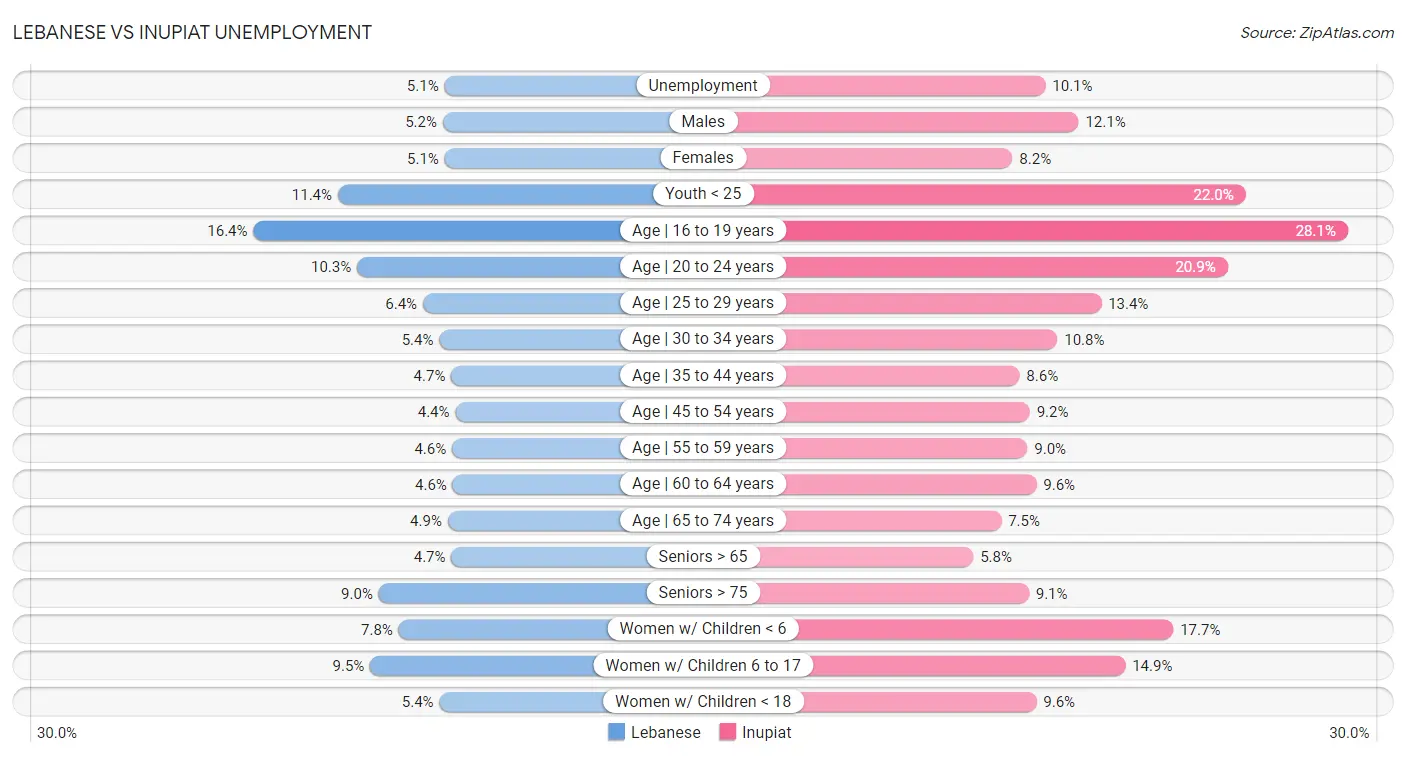
| Unemployment Metric | Lebanese | Inupiat |
| Unemployment | Excellent 5.1% | Tragic 10.1% |
| Males | Good 5.2% | Tragic 12.1% |
| Females | Exceptional 5.1% | Tragic 8.2% |
| Youth < 25 | Excellent 11.4% | Tragic 22.0% |
| Age | 16 to 19 years | Exceptional 16.4% | Tragic 28.1% |
| Age | 20 to 24 years | Average 10.3% | Tragic 20.9% |
| Age | 25 to 29 years | Exceptional 6.4% | Tragic 13.4% |
| Age | 30 to 34 years | Good 5.4% | Tragic 10.8% |
| Age | 35 to 44 years | Average 4.7% | Tragic 8.6% |
| Age | 45 to 54 years | Excellent 4.4% | Tragic 9.2% |
| Age | 55 to 59 years | Exceptional 4.6% | Tragic 9.0% |
| Age | 60 to 64 years | Exceptional 4.6% | Tragic 9.6% |
| Age | 65 to 74 years | Exceptional 4.9% | Tragic 7.5% |
| Seniors > 65 | Exceptional 4.7% | Tragic 5.8% |
| Seniors > 75 | Poor 9.0% | Tragic 9.1% |
| Women w/ Children < 6 | Fair 7.8% | Tragic 17.7% |
| Women w/ Children 6 to 17 | Tragic 9.5% | Tragic 14.9% |
| Women w/ Children < 18 | Good 5.4% | Tragic 9.6% |
Lebanese vs Inupiat Labor Participation
When considering labor participation, the most significant differences between Lebanese and Inupiat communities in the United States are seen in in labor force | age 16-19 (38.6% compared to 35.0%, a difference of 10.2%), in labor force | age 30-34 (84.4% compared to 79.7%, a difference of 5.8%), and in labor force | age 25-29 (84.3% compared to 79.8%, a difference of 5.7%). Conversely, both communities are more comparable in terms of in labor force | age > 16 (64.5% compared to 64.3%, a difference of 0.44%), in labor force | age 20-24 (75.3% compared to 74.6%, a difference of 0.94%), and in labor force | age 45-54 (82.5% compared to 79.9%, a difference of 3.3%).

| Labor Participation Metric | Lebanese | Inupiat |
| In Labor Force | Age > 16 | Tragic 64.5% | Tragic 64.3% |
| In Labor Force | Age 20-64 | Tragic 79.1% | Tragic 76.1% |
| In Labor Force | Age 16-19 | Exceptional 38.6% | Tragic 35.0% |
| In Labor Force | Age 20-24 | Good 75.3% | Poor 74.6% |
| In Labor Force | Age 25-29 | Poor 84.3% | Tragic 79.8% |
| In Labor Force | Age 30-34 | Poor 84.4% | Tragic 79.7% |
| In Labor Force | Age 35-44 | Tragic 83.6% | Tragic 80.9% |
| In Labor Force | Age 45-54 | Poor 82.5% | Tragic 79.9% |
Lebanese vs Inupiat Family Structure
When considering family structure, the most significant differences between Lebanese and Inupiat communities in the United States are seen in single father households (2.1% compared to 4.9%, a difference of 126.6%), births to unmarried women (29.5% compared to 52.1%, a difference of 76.3%), and single mother households (5.9% compared to 8.5%, a difference of 44.3%). Conversely, both communities are more comparable in terms of divorced or separated (11.9% compared to 11.4%, a difference of 4.0%), family households (64.4% compared to 67.8%, a difference of 5.2%), and married-couple households (47.9% compared to 42.4%, a difference of 13.1%).

| Family Structure Metric | Lebanese | Inupiat |
| Family Households | Good 64.4% | Exceptional 67.8% |
| Family Households with Children | Excellent 27.7% | Exceptional 32.8% |
| Married-couple Households | Exceptional 47.9% | Tragic 42.4% |
| Average Family Size | Tragic 3.19 | Exceptional 3.63 |
| Single Father Households | Exceptional 2.1% | Tragic 4.9% |
| Single Mother Households | Exceptional 5.9% | Tragic 8.5% |
| Currently Married | Exceptional 47.9% | Tragic 41.3% |
| Divorced or Separated | Excellent 11.9% | Exceptional 11.4% |
| Births to Unmarried Women | Exceptional 29.5% | Tragic 52.1% |
Lebanese vs Inupiat Vehicle Availability
When considering vehicle availability, the most significant differences between Lebanese and Inupiat communities in the United States are seen in no vehicles in household (8.7% compared to 29.9%, a difference of 245.1%), 2 or more vehicles in household (57.6% compared to 42.6%, a difference of 35.1%), and 1 or more vehicles in household (91.4% compared to 71.5%, a difference of 27.8%). Conversely, both communities are more comparable in terms of 4 or more vehicles in household (6.4% compared to 6.2%, a difference of 2.7%), 3 or more vehicles in household (20.0% compared to 16.9%, a difference of 18.7%), and 1 or more vehicles in household (91.4% compared to 71.5%, a difference of 27.8%).

| Vehicle Availability Metric | Lebanese | Inupiat |
| No Vehicles Available | Exceptional 8.7% | Tragic 29.9% |
| 1+ Vehicles Available | Exceptional 91.4% | Tragic 71.5% |
| 2+ Vehicles Available | Exceptional 57.6% | Tragic 42.6% |
| 3+ Vehicles Available | Good 20.0% | Tragic 16.9% |
| 4+ Vehicles Available | Average 6.4% | Fair 6.2% |
Lebanese vs Inupiat Education Level
When considering education level, the most significant differences between Lebanese and Inupiat communities in the United States are seen in professional degree (5.0% compared to 3.2%, a difference of 58.7%), doctorate degree (2.1% compared to 1.3%, a difference of 57.1%), and master's degree (16.5% compared to 10.5%, a difference of 56.9%). Conversely, both communities are more comparable in terms of 9th grade (95.6% compared to 95.8%, a difference of 0.23%), 10th grade (94.6% compared to 94.4%, a difference of 0.24%), and 8th grade (96.3% compared to 97.0%, a difference of 0.68%).
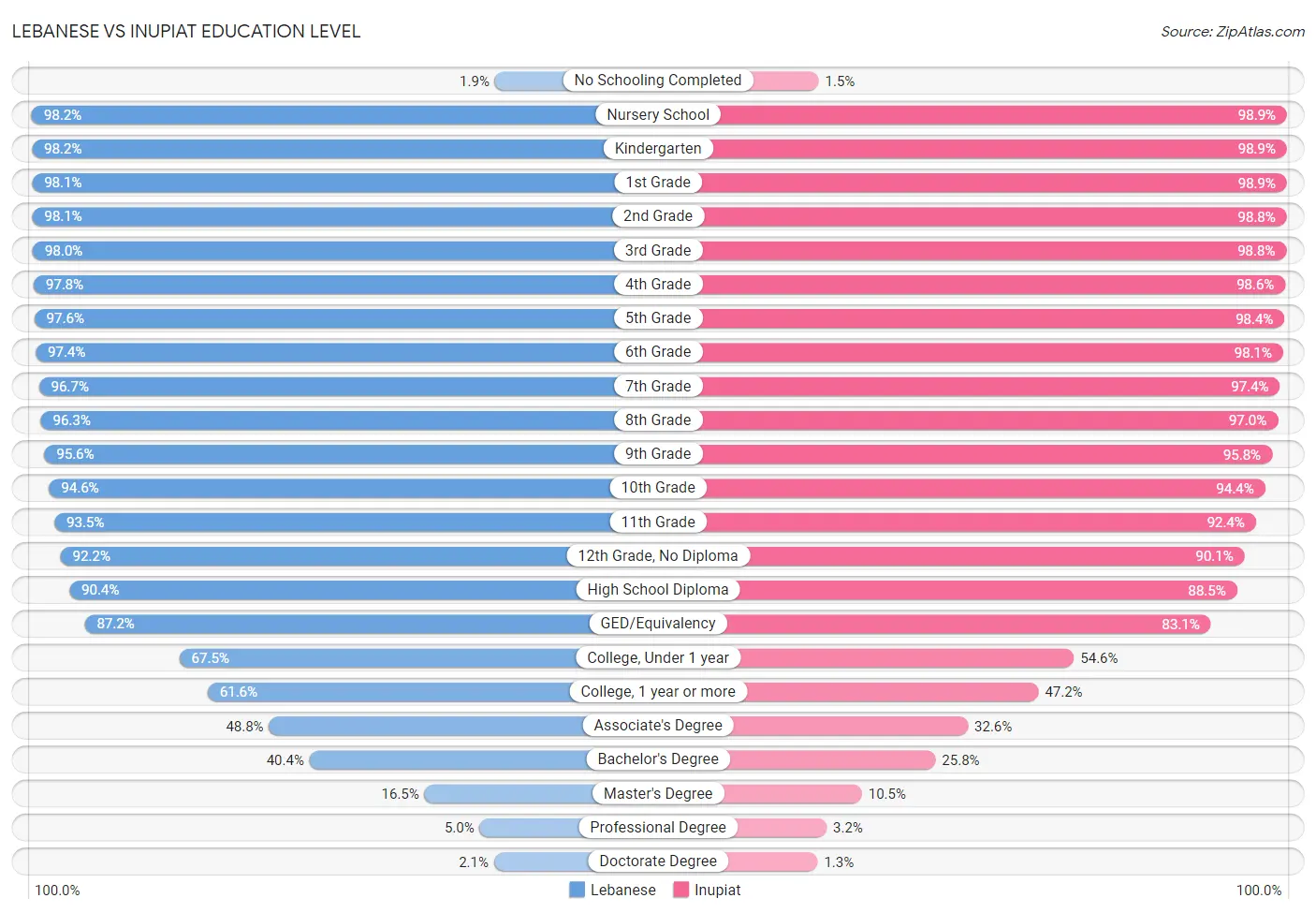
| Education Level Metric | Lebanese | Inupiat |
| No Schooling Completed | Exceptional 1.9% | Exceptional 1.5% |
| Nursery School | Exceptional 98.2% | Exceptional 98.9% |
| Kindergarten | Exceptional 98.2% | Exceptional 98.9% |
| 1st Grade | Exceptional 98.1% | Exceptional 98.9% |
| 2nd Grade | Exceptional 98.1% | Exceptional 98.8% |
| 3rd Grade | Exceptional 98.0% | Exceptional 98.8% |
| 4th Grade | Exceptional 97.8% | Exceptional 98.6% |
| 5th Grade | Exceptional 97.6% | Exceptional 98.4% |
| 6th Grade | Exceptional 97.4% | Exceptional 98.1% |
| 7th Grade | Exceptional 96.7% | Exceptional 97.4% |
| 8th Grade | Exceptional 96.3% | Exceptional 97.0% |
| 9th Grade | Exceptional 95.6% | Exceptional 95.8% |
| 10th Grade | Exceptional 94.6% | Exceptional 94.4% |
| 11th Grade | Exceptional 93.5% | Average 92.4% |
| 12th Grade, No Diploma | Exceptional 92.2% | Tragic 90.1% |
| High School Diploma | Exceptional 90.4% | Poor 88.5% |
| GED/Equivalency | Exceptional 87.2% | Tragic 83.1% |
| College, Under 1 year | Exceptional 67.5% | Tragic 54.6% |
| College, 1 year or more | Exceptional 61.6% | Tragic 47.2% |
| Associate's Degree | Exceptional 48.8% | Tragic 32.6% |
| Bachelor's Degree | Exceptional 40.4% | Tragic 25.8% |
| Master's Degree | Exceptional 16.5% | Tragic 10.5% |
| Professional Degree | Exceptional 5.0% | Tragic 3.2% |
| Doctorate Degree | Exceptional 2.1% | Tragic 1.3% |
Lebanese vs Inupiat Disability
When considering disability, the most significant differences between Lebanese and Inupiat communities in the United States are seen in disability age under 5 (1.3% compared to 3.7%, a difference of 180.9%), disability age 65 to 74 (22.5% compared to 34.5%, a difference of 53.5%), and hearing disability (3.2% compared to 4.7%, a difference of 47.2%). Conversely, both communities are more comparable in terms of cognitive disability (17.0% compared to 16.9%, a difference of 0.70%), disability age 5 to 17 (5.6% compared to 5.7%, a difference of 2.1%), and disability (11.8% compared to 12.2%, a difference of 2.8%).
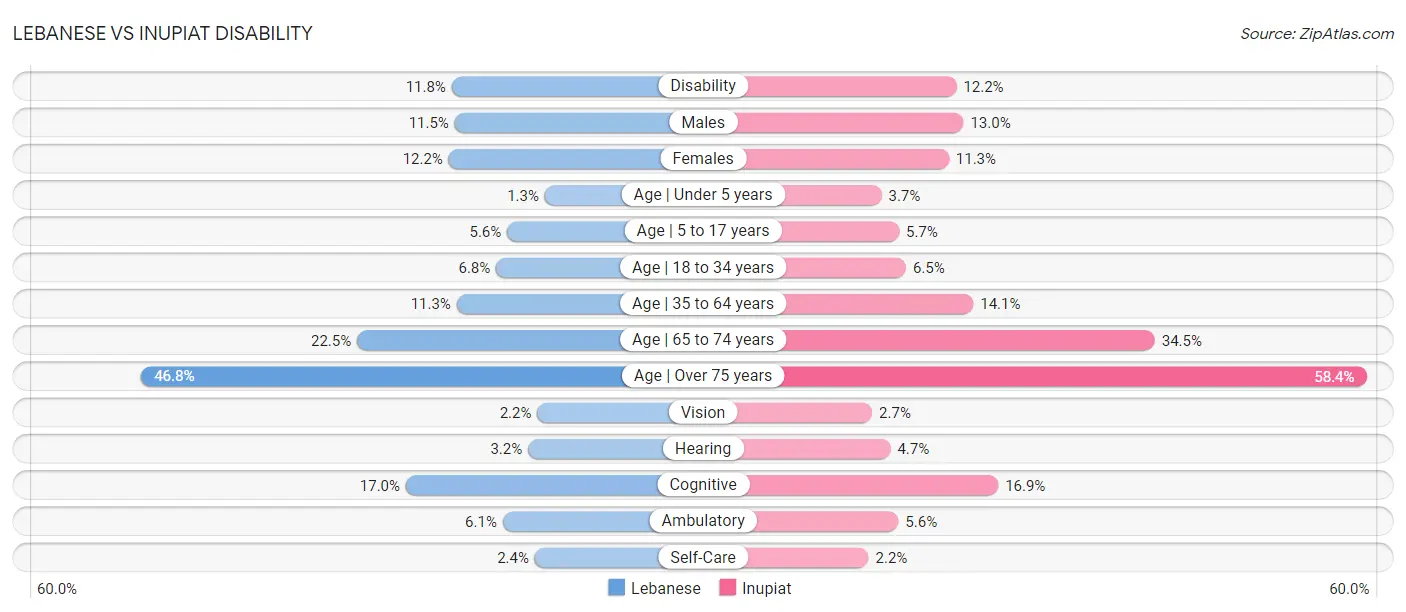
| Disability Metric | Lebanese | Inupiat |
| Disability | Fair 11.8% | Tragic 12.2% |
| Males | Poor 11.5% | Tragic 13.0% |
| Females | Average 12.2% | Exceptional 11.3% |
| Age | Under 5 years | Tragic 1.3% | Tragic 3.7% |
| Age | 5 to 17 years | Good 5.6% | Fair 5.7% |
| Age | 18 to 34 years | Poor 6.8% | Good 6.5% |
| Age | 35 to 64 years | Average 11.3% | Tragic 14.1% |
| Age | 65 to 74 years | Exceptional 22.5% | Tragic 34.5% |
| Age | Over 75 years | Excellent 46.8% | Tragic 58.4% |
| Vision | Average 2.2% | Tragic 2.7% |
| Hearing | Tragic 3.2% | Tragic 4.7% |
| Cognitive | Exceptional 17.0% | Exceptional 16.9% |
| Ambulatory | Good 6.1% | Exceptional 5.6% |
| Self-Care | Good 2.4% | Exceptional 2.2% |